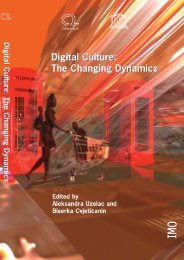free download in pdf format - Culturelink Network
free download in pdf format - Culturelink Network
free download in pdf format - Culturelink Network
You also want an ePaper? Increase the reach of your titles
YUMPU automatically turns print PDFs into web optimized ePapers that Google loves.
Erased languages, aroused alliances - language policy and post-Yugoslav political and...<br />
Criticism of erased people’s poor knowledge of Slovene repeatedly crops up <strong>in</strong><br />
discussions about the regulation of their status and rights. Th e <strong>in</strong>terviews with the<br />
erased people conducted <strong>in</strong> 2007, 2008 and 2009 as part of the Peace Institute’s research<br />
study “Th e Erased People of Slovenia – A Challenge for the Young Nation-State” reveal<br />
that many among them, but primarily fi rst-generation immigrants, <strong>in</strong>deed do not have a<br />
good command of Slovene. Many of them speak a mixture 2 of Slovene and their mother<br />
tongue – Serbian, Croatian, Bosnian or other. 3<br />
Why is this so? Why do many erased people and other members of the fi rst generation<br />
of immigrants lack a good command of Slovene?<br />
Workers from other republics of the former Yugoslavia immigrated to Slovenia when the<br />
latter was still part of Yugoslavia. At the time of their immigration and until 1991, when<br />
Slovenia as a sovereign state adopted the new constitution, Article 6 of the Constitution<br />
of the Socialist Republic of Slovenia (dat<strong>in</strong>g from 1974) provided that citizens of other<br />
socialist republics of Yugoslavia had “the same rights and obligations <strong>in</strong> Slovenia as the<br />
citizens of Slovenia”. Provisions relat<strong>in</strong>g to language were laid out <strong>in</strong> Article 212 of this<br />
constitution. In accordance with this article, everyone had the right to “cultivate and express<br />
his culture and use his language and script”; the language of all bodies, organizations and<br />
<strong>in</strong>dividuals perform<strong>in</strong>g a “social function” <strong>in</strong> the Republic of Slovenia (RS) was Slovene,<br />
and everyone had “the right to use his language and script when realiz<strong>in</strong>g his rights<br />
and obligations and <strong>in</strong> procedures before state and other bodies and organizations that<br />
perform a social function. A body conduct<strong>in</strong>g such a procedure is obliged to supply the<br />
material and <strong>in</strong><strong>format</strong>ion on its work <strong>in</strong> his language and <strong>in</strong> the manner provided by law”.<br />
Th e last paragraph of this article stated that “the lack of knowledge of Slovene cannot<br />
be an obstacle h<strong>in</strong>der<strong>in</strong>g anyone’s defense, exercise of rights or justifi ed <strong>in</strong>terests”. Article<br />
213 stated that “members of other Yugoslav nations and nationalities have, <strong>in</strong> accordance<br />
with the law, the right to education and school<strong>in</strong>g <strong>in</strong> their own language”.<br />
2 A mixture of languages or a hybrid language is a special l<strong>in</strong>guistic, cultural and social<br />
phenomenon. It has recently received signifi cant attention and s<strong>in</strong>gular approval from the<br />
Slovenian public especially aft er the success of Goran Vojnović’s book Čefurji raus! (Čefur,<br />
plural čefurji, is a derogatory term for non-Slovenes com<strong>in</strong>g from the former Yugoslav<br />
republics). Hybrid languages are characteristic of many multil<strong>in</strong>gual societies, particularly<br />
those where immigrants account for a large part of the population.<br />
3 Aft er the emergence of the new countries follow<strong>in</strong>g the dissolution of Yugoslavia, Croato-<br />
Serbian or Serbo-Croatian also split <strong>in</strong>to several national languages, i.e. Croatian, Serbian,<br />
Bosnian and, recently, Montenegr<strong>in</strong>. For more on what happened to Serbo-Croatian or<br />
Croato-Serbian and whether it is possible to say that this language still exists, see Bugarski’s<br />
discussion “O starom jeziku i novim jezicima” (On the Old Language and New Languages)<br />
(Bugarski, 2009: 121-127).<br />
73



